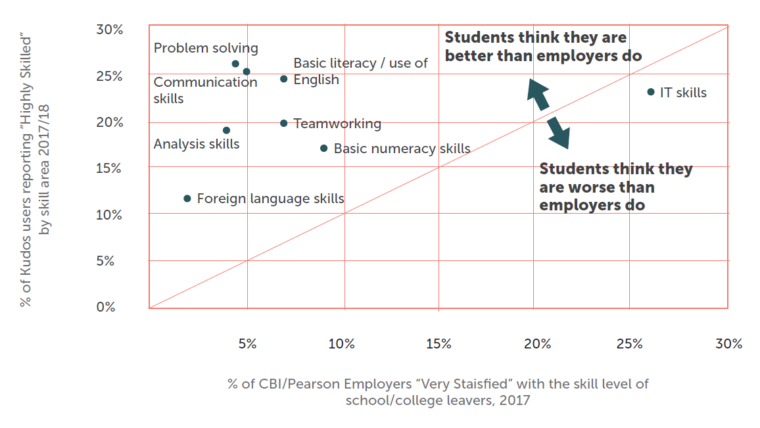Jordan Rehill (Research Analyst, Education and Employers)
The latest figures from the Office for National Statistics (ONS) published earlier this month provide a stark reminder of the challenge that young people face when looking for stable and secure employment. While overall NEET (Not in Education, Employment or Training) figures for 18-24-year olds have declined in the last ten years, the number of unemployed young people aged 16-24 that have been looking for work for over 12 months increased by nearly 8,000 in the last year (a 2% increase).

These findings from the ONS come at a time when employers continue to express concerns over the work readiness of school leavers. The Department for Education’s Employer Perspectives Survey found that only 58% of young people leaving education were considered prepared for work by employers (2017). Figures from our recent study with CASCAID also compare students’ perceptions of their own skills with employers’ skills demand, and illustrates there is a real difference between what they think they are good at and what employers rate highly.
As our previous work on this subject has shown, structural changes in how employers recruit and what skills are required by the modern labour market have significance for schools and for young people (2018). Businesses are increasingly looking for a broader set of skills and competencies reflecting an expectation of continual change within workplaces considering technological advancements, globalisation and geopolitical factors.
Student self-reported skill levels compared with employer experience (source: CASCAID – The Future of work)

Returning to the ONS data, a deeper dive into these employment figures uncovers a sharp rise of ‘atypical’ work. Since 2013, the number of 18-24-year olds on zero-hour contracts increased by 73,000 (2019). As the work from the Resolution Foundation below shows, almost two-thirds of net employment growth since 2008 has been in what they describe as ‘atypical’ work, which includes self-employment, part-time work, agency work, or work on a zero hours contract.
Change in employment since 2008, 16+ year olds (source: Resolution Foundation – Setting the Record Straight)

A recent government report exploring the experiences of young people in the gig economy highlights the perceived benefits of this type ‘atypical’ of work. For young people, such employment represents an opportunity to accumulate the skills, knowledge and experience needed for their eventual full-time employment. Whether this form of flexible, yet unpredictable, work represents a positive step for our young people when entering the labour market remains to be seen. What is clear, however, is a pressing need to ensure our young people do not feel that they must move into insecure jobs to gain the work-related knowledge and experience needed to move on to their chosen careers.
Connecting young people with employers and volunteers from the world of work can be part of the solution in preparing young people for an increasingly competitive and changing jobs market. Our extensive research exploring the impact of career-related learning shows that the more young people encounter employers whilst at school the more they earn and the lower their chances of becoming NEET as young adults.
Supporting young people’s transitions into the world of work also requires a more concerted effort from employers in directing young people towards alternative routes to the labour market. As a recent report by the Sutton Trust has shown, 18-24-year olds are currently the only age group to believe that going into higher education offers a better opportunity than apprenticeships or further education. Our recent report on teenage apprenticeships highlighted that the more times a young person heard from an employer or apprentice the more likely they were to apply to an apprenticeship. The report also showed that the timing of this advice is crucial too. Schools that are more successful in getting under 19s into apprenticeships give advice and guidance at a younger age.
Even if the underlying messages and content are similar between an employer-led and a teacher-led session on a particular career or the nature of working life, a volunteer from the world of work may be able to convey greater authenticity, ultimately enabling more messages to stick and drive impactful attitudinal or behavioural change.
Such benefits are clearly dependent on how career guidance is delivered and where young people encounter it. Ad hoc activities organised a few weeks before a young person leaves school is unlikely to be particularly effective. However, a wraparound programme of career education and employer engagement throughout a young person’s education is far more likely to forge a change that will ease their journey to the labour market.
